#eulalia: exteriors
Text
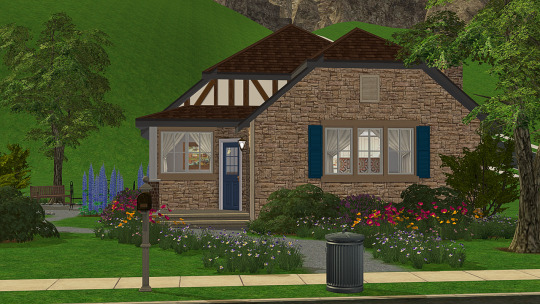
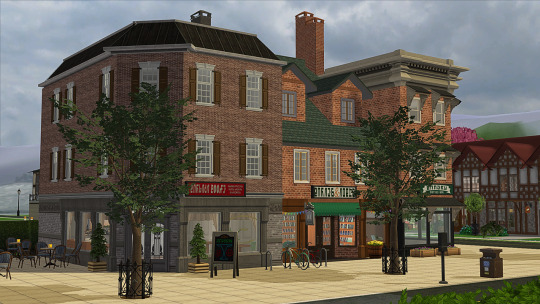
Lately my gaming time has been spent on Stardew Valley (this run I'm finally gonna ask Krobus to be my platonic life partner/roommate 🥰), but also I started poking at this project again, which is a neighborhood that will theoretically become a vacation destination for Middleground.
inspo: one | two
#ts2#eulalia: exteriors#pinterest has recently led me to discover railway and other models for building inspo#I have a bunch saved on my pinterest inspo board if anyone's intrigued (link's in my pinned post)#also my cat Juno is doing well currently on her new meds; thank you to the ppl who've asked after her :)
159 notes
·
View notes
Text

Sachiko extrañaba la casa, desde luego, pero probablemente lo que no la dejaba dormir era el extremo cansancio. Se había levantado temprano, la habían zarandeado y baqueteado en tren y automóvil con todo el calor del día, y por la noche había corrido los campos con los niños, tres o cuatro kilómetros por lo menos… Con todo estaba segura de que sería bonito recordar la caza de luciérnagas. Sólo había visto tal cosa en el teatro de títeres: Miyuki y Komazawa susurrándose amores mientras navegaban río Uji abajo. Y desde luego había que vestir como cuadraba: quimono de rozagantes mangas, con un elegante motivo de verano, y correr por los campos con las mangas al viento, prendiendo con delicadeza de tanto en tanto una luciérnaga de debajo del abanico. Sachiko estaba embelesada con el cuadro. Pero de hecho una caza de luciérnagas era algo muy distinto. Les dijeron que si iban a salir a corretear por el campo era mejor que se cambiaran, y les sacaron cuatro quimonos de muselina, quizá especialmente dispuestos para ellas, cada uno con un diseño diferente, según correspondía a sus diferentes edades. «¡Nada que ver con las estampas!», dijo entre risas una de las hermanas. Casi era de noche después de todo, poco importaba lo que llevaran puesto. Cuando salieron de la casa todavía distinguían sus rostros entre sí, pero para cuando llegaron al río era prácticamente noche cerrada. Lo llamaban río, pero en verdad era poco más que una reguera entre los arrozales, algo más ancha quizá de lo normal, con gachos airones de eulalia en ambas márgenes, casi tapando la corriente. Aún se columbraba un pontezuelo a un centenar de metros.
Apagaron sus linternas y se acercaron en silencio: a las luciérnagas les molesta el ruido y la luz. Pero ni siquiera en la misma orilla había ninguna. «Igual no han salido esta noche», dijo alguien. «No, hay muchísimas. Venid por aquí.» Abajo en las hierbas de la ribera, en el sutil instante cuando se extingue el último resplandor, estaban las luciérnagas, rasando el agua en arcos, al vaivén del herbazal… Y aguas abajo, sin fin, sartas de luciérnagas ondulaban desde ambas márgenes, yendo y viniendo… trazando sus difusas líneas luminosas a flor de agua, ocultas del exterior por las altas hierbas… Sachiko lo seguía viendo, acostada con los ojos cerrados. En el postrero fulgor, entre la lobreguez que emanaba del agua y los plumeros que se mecían vagamente silueteados, allá, por todo el largo cauce, un número infinito de breves trazos de luz en dos largas bandas, mudas, irreales. Sin duda fue el apogeo de la noche, el momento que hizo que la excursión valiera la pena. Una caza de luciérnagas no tenía en absoluto la brillantez de una gira para ver los cerezos en flor. Era más bien, digamos, sombría, ensoñada. Tenía algo de la fantasía de la infancia, del mundo de los cuentos de hadas… Algo trasladable a la música, más que a la pintura, cuya atmósfera podía quizás captar el piano o el koto. Y mientras yacía con los ojos cerrados, las luciérnagas seguían guiñando sus luces a todo lo largo del río, toda la noche, calladas, infinitas. Sachiko sintió un arrebatado ímpetu, como si se uniera a ellas flotando y calando sobre la haz del agua, trazando su propia estela de luz.
Habían recorrido un gran trecho —ahora que lo pensaba—, siguiendo el riacho tras las dichosas luciérnagas. De vez en cuando cruzaban una pasarela, mudando de ribera, con cuidado de no caerse, pendientes de las serpientes, de sus ojos que fulgen igual que las luciérnagas. Sōsuke, el chico de seis años de Sugano, abría la marcha en la tiniebla, pues conocía al dedillo el terreno, y su padre, que las guiaba, lo llamaba inquieto: «¡Sōsuke, Sōsuke!». Ya nadie se preocupaba de si espantaban a las luciérnagas: había tantas… Además si no se llamaban entre ellos, corrían el riesgo separarse en la oscuridad, cada uno siguiendo por su lado a sus luciérnagas. En un momento Sachiko y Yukiko se quedaron solas en una orilla y desde la opuesta llegaban voces, ya claras ya emborronadas por el viento, llamando: «¡Madre!… ¿Dónde está madre?… Por aquí… ¿Y Yukiko?… Está aquí conmigo… Yo tengo ya veinticuatro… ¡No te vayas a caer al agua!».
Sugano arrancó alguna hierba por el camino e hizo un atadillo como una escoba: «Para guardar las luciérnagas», dijo. «Hay sitios famosos por sus luciérnagas como Moriyama en Omi, o los arrabales de Gifu, pero están acotados para la gente importante. Aquí a nadie le preocupa cuántas cojas.» Y Sugano atrapó más que nadie. Padre e hijo bajaban atrevidamente hasta el mismo borde del agua y la escoba de Sugano se enjoyó de luces. Sachiko y las otras empezaron a preguntarse cuándo daría por terminada la partida. «El viento es frío; quizás sea hora, ¿no le parece?» «Pero si ya vamos de vuelta, sólo que por otro camino.» Siguieron caminando; habían ido más lejos de lo que pensaban. Y de pronto estaban ante la puerta de atrás de casa de Sugano, cada uno con sus pocas luciérnagas; Sachiko y Yukiko con algunas en las mangas…
Los acontecimientos de la velada se sucedían sin orden en la mente de Sachiko. Abrió los ojos: quizás lo había soñado. Sobre ella, a la luz de la diminuta bombilla, podía ver un cuadro enmarcado en el que ya se había fijado el día anterior: tenía escrito en grandes caracteres Pabellón de la Intemporalidad, firmado por un tal Keidō. Sachiko contempló las palabras sin saber quién sería Keidō. Una centella cruzó la habitación contigua. Espantada por el incienso contra los mosquitos, una luciérnaga estaba buscando la salida. Habían soltado sus luciérnagas antes en el jardín y muchas se metieron en la casa. Pero las ahuyentaron metódicamente antes de cerrar las puertas para dormir. ¿Dónde habría estado escondida aquélla? Con un postrero arranque de energía voleteó un par de metros y luego planeó agotada por la habitación, yendo a posarse en el quimono de Sachiko, colgado del galán. Se movió por el estampado y entró por la bocamanga, brillando tenue a través de la fina tela gris azulada. El sahúmo del pebetero en forma de tejón estaba empezando a agarrársele a la garganta a Sachiko. Se levantó a apagarlo, y ya que estaba se acercó a ver la luciérnaga. La recogió con cuidado en un pedazo de papel, porque tocarla le daba repelús, y la sacudió fuera por una ranura del postigo. El jardín estaba negro como laca. De las docenas de luciérnagas que latían antes entre las matas y por la orilla del estanque no quedaba casi ninguna. ¿Habrían vuelto al río?
Tanizaki Jun'ichirō
#Tanizaki Jun'ichirō#literatura japonesa#excursión#verano#luciérnagas#hermanas#visión#traducción©ochoislas
2 notes
·
View notes
Text
INTRODUCTION TO BARCLEONA

The Casa de les Punxes or Casa Terradas, designed by Josep Puig i Cadafalch.

Casa Batlló - in the center of Barcelona. Designed by Antoni Gaudí. It is considered one of his masterpieces. A remodel of a previously built house, it was redesigned in 1904 by Gaudí and has been refurbished several times after that. The local name for the building is Casa dels ossos (House of Bones), as it has a visceral, skeletal organic quality.
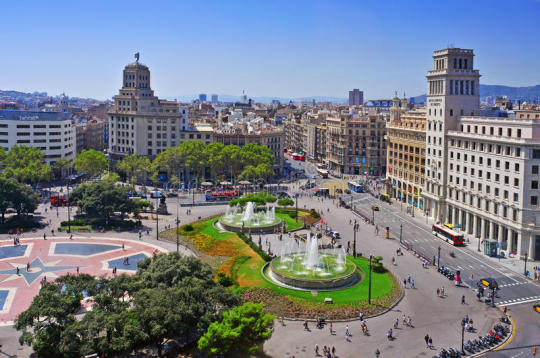
Plaça Catalunya - The plaza occupies an area of about 50,000 square metres. It is especially known for its fountains and statues, its proximity to some of Barcelona's most popular attractions, and the flocks of pigeons that gather in the centre.

La Rambla - is a street in central Barcelona. A tree-lined pedestrian street, it stretches for 1.2 kilometres connecting Plaça de Catalunya in the centre with the Christopher Columbus Monument at Port Vell.
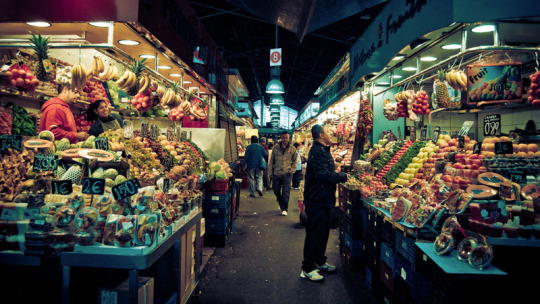
La Boqueria food market - is a large public market in the Ciudad Vieja district of Barcelona, Catalonia, Spain, and one of the city's foremost tourist landmarks, with an entrance from La Rambla, not far from the Liceo, Barcelona's opera house.

Gothic Quarter - The charming Gothic Quarter, or Barri Gòtic, has narrow medieval streets filled with trendy bars, clubs and Catalan restaurants. The Museu d'Història de Barcelona shows remains of the Roman city. Artisans sell leather and jewellery near the Cathedral of Barcelona, while flower stalls and street-food vendors line busy avenue La Rambla. The Plaça del Pi, named after the adjacent Gothic church, hosts a weekend art market.
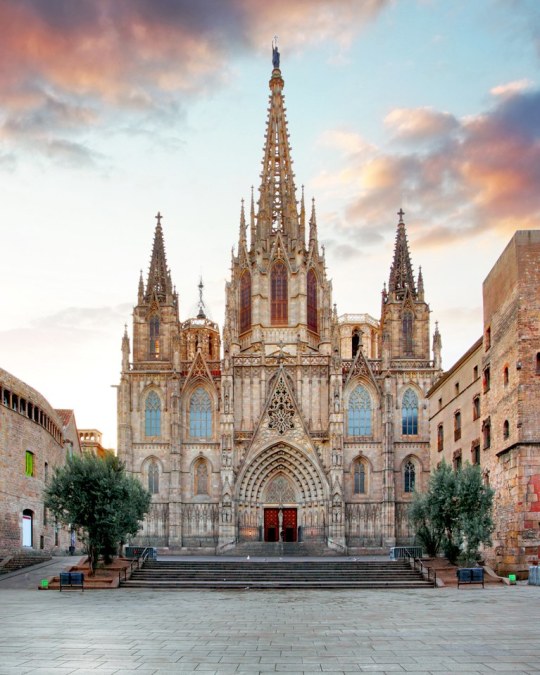
Barcelona Cathedral - The Cathedral of the Holy Cross and Saint Eulalia, also known as Barcelona Cathedral, is the Gothic cathedral and seat of the Archbishop of Barcelona, Catalonia, Spain. The cathedral was constructed from the thirteenth to fifteenth centuries, with the principal work done in the fourteenth century.

Basilica of Santa Maria del Mar - is a church in the Ribera district of Barcelona, Spain, built between 1329 and 1383 at the height of Principality of Catalonia's maritime and mercantile preeminence. It is an outstanding example of Catalan Gothic, with a purity and unity of style that is very unusual in large medieval buildings.
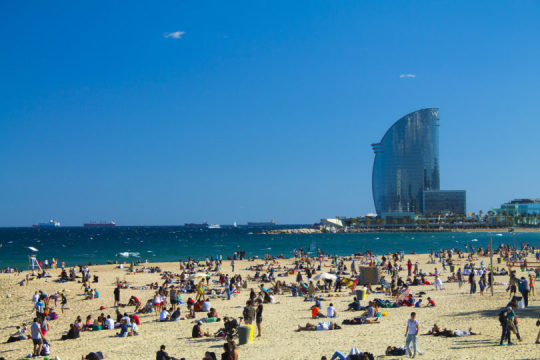
Beach

Park Güell - is a public park system composed of gardens and architectonic elements located on Carmel Hill, in Barcelona, Catalonia, Spain. Park Güell is the reflection of Gaudí's artistic plenitude, which belongs to his naturalist phase. During this period, the architect perfected his personal style through inspiration from organic shapes.
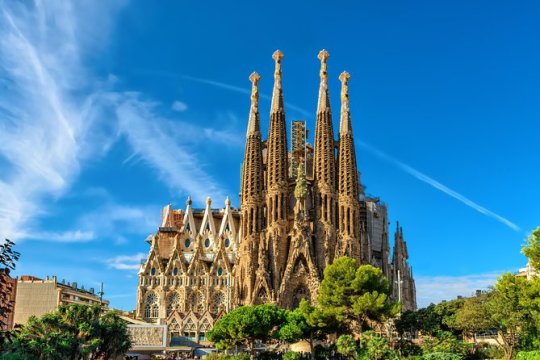


La Sagrada Familia - is a large unfinished Roman Catholic minor basilica in Barcelona, Catalonia, Spain. Designed by Catalan architect Antoni Gaudí. On 19 March 1882, construction of the Sagrada Família began under architect Francisco de Paula del Villar. In 1883, when Villar resigned, Gaudí took over as chief architect, transforming the project with his architectural and engineering style, combining Gothic and curvilinear Art Nouveau forms.
Gaudí devoted the remainder of his life to the project, and he is buried in the crypt. At the time of his death in 1926, less than a quarter of the project was complete. Relying solely on private donations, the Sagrada Família's construction progressed slowly and was interrupted by the Spanish Civil War. In July 1936, revolutionaries set fire to the crypt and broke their way into the workshop, partially destroying Gaudí's original plans, drawings and plaster models, which led to 16 years work to piece together the fragments of the master model.

Casa Milà - popularly known as La Pedrera or "The stone quarry", a reference to its unconventional rough-hewn appearance, is a modernist building. It was the last private residence designed by architect Antoni Gaudí and was built between 1906 and 1912. The building was commissioned in 1906 by Pere Milà [ca; es] and his wife Roser Segimon [ca; es]. At the time, it was controversial because of its undulating stone facade, twisting wrought iron balconies and designed by Josep Maria Jujol. Several structural innovations include a self-supporting stone façade, and a free-plan floor, underground garage and the spectacular terrace on the roof.

Fundació Joan Miró - is a museum of modern art honoring Joan Miró. His connection to the land and his interest in everyday objects and in the natural environment formed the backdrop to some of his technical and formal research. Self-contained in his manners and public expressions, it is through art that Joan Miró showed his rebelliousness and a strong sensitivity to the political and social events around him.

Montjuïc Castle - is an old military fortress, with roots dating back from 1640. In the last 350 years Montjuïc Castle has played a decisive role in the history of Barcelona, becoming a symbol after the Catalan defeat to Spain in 1714. Since then the Montjuïc cannons have bombarded the city and its citizens on various occasions, and Montjuïc has been used as a prison and torture centre repeatedly for three centuries.The castle is infamous in Catalan history books because of its role in the civil war from 1936 to 1939 when both sides of the conflict imprisoned, tortured and shot political prisoners at Montjuïc, among them Lluís Companys, who was the president of the Generalitat of Catalonia during the Spanish Civil War. Companys was executed upon orders from the Spanish State at Montjuïc Castle in 1940.

Barcelona Pavilion - designed by Ludwig Mies van der Rohe and Lilly Reich, was the German Pavilion for the 1929 International Exposition in Barcelona, Spain. The pavilion for the International Exhibition was supposed to represent the new Weimar Germany: democratic, culturally progressive, prospering, and thoroughly pacifist; a self-portrait through architecture.

Jardí Botànic de Barcelona (Botanic Garden) - set amongst a number of stadiums used in the Summer Olympic Games of 1992. Although a botanical garden had been established in Barcelona as early as 1888, the current gardens date from 1999. “After only a few minutes of walking around the Botanic Gardens I felt I had entered a Zen monastery, calm and peace and cleanliness.”

Bibliotec Sant Antoni (Joan Oliver) - The library, named in honor of playwright and poet Joan Oliver, came about through a competition won by RCR in 2005. The architects sought to make the street more dynamic and to open up the inner courtyard for public use, as well as to create a library. The glass-enclosed main reading room is raised up and set between the two lateral wings of the library, which allow light to filter through from both sides, forming a gateway into the public space. This courtyard, with its trees, earthen paving, sitting areas, games, etc. can be understood as an extension of the library’s reading rooms.
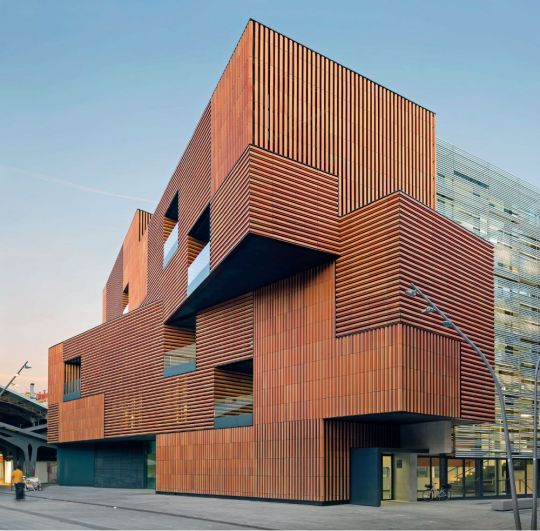

Plaza de la Gardunya - Escuela Massana (school of Art and Design) is part of the long process of urban transformation of Plaza de la Gardunya, located in Barcelona’s historical centre. the effort put into this project responds to the desire of creating a bright interior space with open connecting spaces whilst, at the same time, the exterior of the building remains in harmony with the urban fabric. The building showcases different volumetries and façade textures as a response to the surrounding buildings. With the aim of giving it a more unique and sculptural look and, at the same time, make it more airy, the section that faces onto the square is divided into two sections slightly rotated, creating terraces.
The school, which is an institution that welcomes future artisans and designers, is clad in a ceramic material of large dimensions, made in an artisanal manner and unique to our building. This helped to give it its unique character and highlights the sculptural nature of the building, whilst protecting the privacy of the students.
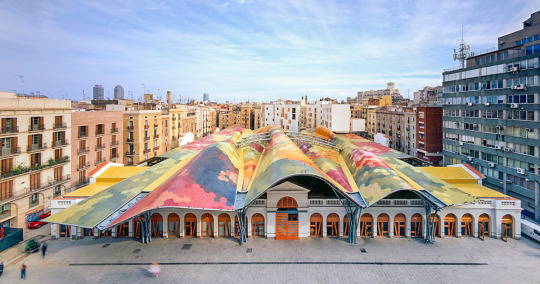
Santa Caterina Food Market - Buzzy market featuring a unique, wavy roof & colourful mosaics, with a variety of vendors & eateries. A competition was opened to restore the Santa Caterina city market located in the old quarter of Barcelona in 1997. EMBT won the bid with a proposal that aimed at incorporating the extreme complexity of the setting itself by creating a commercial market complemented by a residential zone and public spaces that integrated all the activities of the neighbourhood.
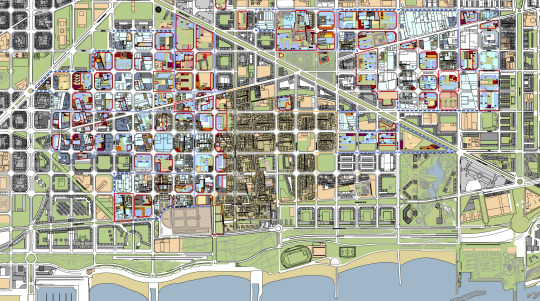
22@ District - is the corporative name given to an urban renewal area in Barcelona's formerly industrial area of Poblenou, in the district of Sant Martí, nicknamed "the Catalan Manchester" in the 19th century. Its aim is to convert Poblenou into the city's technological and innovation district, as well as to increase leisure and residential spaces. Centered on Plaça de les Glòries Catalanes, it is part of one of Europe's biggest urban regeneration schemes, begun during the 2000s and still ongoing.

The Museu del Disseny de Barcelona - is a new center of Barcelona's Institute of Culture, acting as a museum and laboratory. It focuses on 4 branches or design disciplines: space design, product design, information design and fashion. Barcelona is a city historically linked to design. It was decided to build a single space in which locate all collections and endowments existing in Barcelona related to the world of design, and Oriol Bohigas commissioned the construction of a building in the Plaça de les Glòries.

Torre Glòries - is a 38-story skyscraper which marks the gateway to the new technological district of Barcelona. It was designed by French architect Jean Nouvel in association with the Spanish firm b720 Fermín Vázquez Arquitectos and built by Dragados. Torre Agbar is intended to recall the shape of a geyser rising into the air. It was inspired by Montserrat, a mountain near Barcelona. In an interview, he described the tower as having a phallic character.

Edifici Mediatic - Enric Ruiz-Geli doesn’t emphasise the media impact of his futuristic building, but instead its energy efficiency. Extensive studies formed the basis for the parametric design where the award-winning steel frame is on the outside and the interior offers flexible use of space. The patented cushions made of ETFE membranes are controllable, allowing the different façades to be insulated, opened, or shaded as needed. Edifici MediaTIC is a prime example of forward-looking architecture.
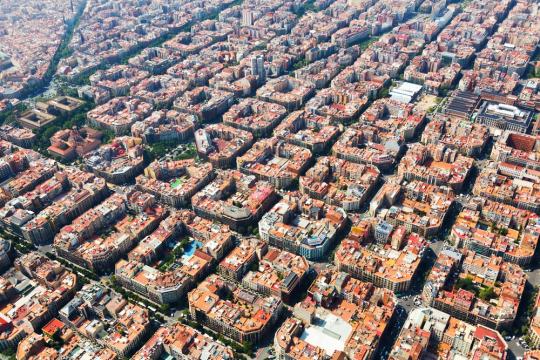
Urban Superblocks - Barcelona’s radical plan to take back streets from cars. A vision for a different way of living in the 21st century, one that steps back from many of the mistakes of the auto-besotted 20th century, refocusing on health and community. It is a bigger and more ambitious city plan than anything being discussed in America and, more important, a plan that is actually being implemented, with a few solid pilot projects behind it, a list of lessons learned, and a half-dozen new projects in the works.
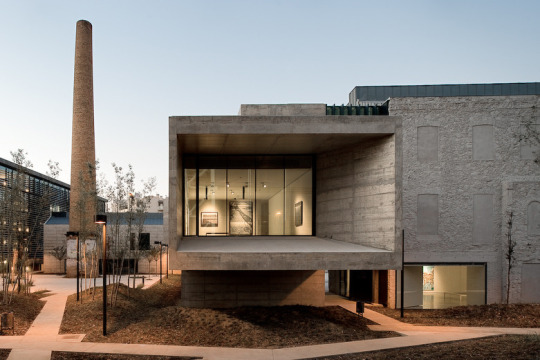
Can Framis Museum - Is an art center devoted to the promotion of contemporary Catalan painting. Located in the old Can Framis factory complex, the museum displays more than 250 paintings from the sixties to the present made by artists born or currently living in Catalonia.
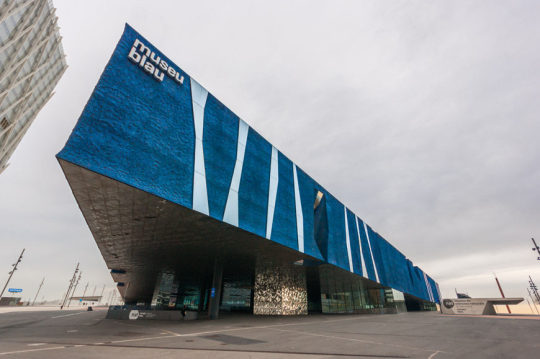
Museu Blau (Science Museum) – By Herzon De Meuron “We look for materials which are as intelligent, versatile and complex as natural phenomena, in other words materials which don't just appeal to the eyes of the astounded art critic, but are also really efficient and appeal to all our senses.” – Jacques Herzog. A triangular mass of gray-blue concrete punctured and split in places to reveal the contrasting use of reflective planes.


Walden 7 - is an apartment building designed by Ricardo Bofill's team and located close to Barcelona, in Catalonia. It was built in 1975. The original project includes 446 residences. The original exterior façade was covered with small, red ceramic tiles backed with the wrong adhesive, creating a pedestrian hazard as the tiles fell off the building.
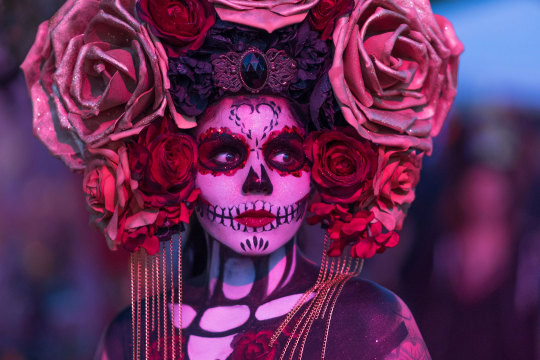
The day of the Dead - is a Mexican holiday celebrated throughout Mexico, and by people of Mexican heritage elsewhere. The holiday involves family and friends gathering to pray for and remember friends and family members who have died, and helping support their spiritual journey. In Mexican culture, death is viewed as a natural part of the human cycle. Mexicans view it not as a day of sadness but as a day of celebration because their loved ones awake and celebrate with them. Mexican cempasúchil (marigold) is the traditional flower used to honor the dead.


Igualada Cemetery - Designed by the architects Enric Miralles and Carme Pinós after winning an architectural competition in 1984. the cemetery became widely regarded as one of the most poetic works of twentieth century Catalan architecture. to explore poetic ideas regarding the acceptance of the cycle of life to enable a link between the past, the present, and the future. A processional "street" descends from the entrance, where crossed, rusting, steel poles doubling as gates and likened to the crosses at Calvary, proclaim the start of a winding pathway towards the burial area. The route is lined with repeatable concrete loculi forming retaining walls and the floor of the path has railway sleepers set into its concrete surface.The intention was to bring the bereaved down into the landscape to a 'city of the dead', an in between place where the dead and the living are brought closer together. The spaces are designed to provoke thoughts and memories.
2 notes
·
View notes
Text
Ermita rupestre de Campo de Ebro
Ermita rupestre de Campo de Ebro
La iglesia rupestre de San Miguel o de Santa Eulalia está situada inmediatamente detrás de la iglesia parroquial de San Millán (s. XVI), construida en época posterior. Es una ermita excavada en un montículo de roca arenisca posiblemente de época altomedieval.
Exterior ermita rupestre de Campo de Ebro
Es pequeña, con una sola nave rectangular alargada y ábside de planta cuadrangular, con sus…
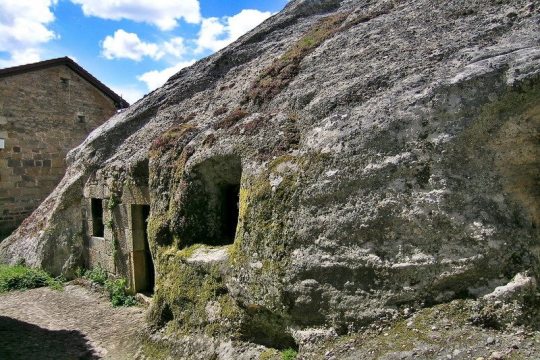
View On WordPress
0 notes
Photo

New Post has been published on https://notimundo.com.mx/seguridad/logra-fiscalia-sentencia-de-30-anos-de-carcel-contra-un-sujeto/
Logra Fiscalía sentencia de 30 años de cárcel contra un sujeto

A través de un Juicio Oral, la Fiscalía de Distrito Zona Centro logró una sentencia condenatoria en contra de Juan Antonio Montalvo García, por su participación en un atentado contra la vida de un policía investigador.
Habiéndose demostrado que el día 31 de enero del año 2019, Juan Antonio Montalvo García y diversa persona, dispararon con armas de fuego al afectado a cuando éste se encontraba al exterior de un domicilio ubicado en la colonia Real de Santa Eulalia, causándole heridas que pusieron en riesgo su vida.
Durante el proceso de la investigación se obtuvieron las pruebas en torno a la participación del ahora sentenciado, evidencias que fueron expuestas en el juicio por un agente del Ministerio Público de la Unidad Especializada en Investigación de Delitos contra la Vida responsable de la investigación.
Tras analizar lo expuesto por la representación social, un Juez resolvió dictar una sentencia condenatoria de 30 años, 11 meses de prisión en contra de Juan Antonio Montalvo García, por los delitos de, Homicidio Calificado en grado de tentativa y posesión de vehículo con reporte de robo.
0 notes
Text
20 things you should not miss in Barcelona
20 things you should not miss in Barcelona
Barcelona is a city with a charming air. It has an ideal cosmopolitan atmosphere to receive all types of travelers. Not for nothing is it one of the most tourist cities in Europe. Barcelona has an excellent cultural and gastronomic offer worth experiencing in addition to its beaches and beautiful landscapes. There is certainly a lot to do in Barcelona.
It is enough to walk through its streets to realize that this city really is an artistic and architectural gem.
For this reason and you have arrived and are looking for what to do in Barcelona this weekend, here we suggest some excursions and walks that will help you feel the historical and cultural richness that you can only get on the shores of the Mediterranean Sea, in Barcelona.
What to do in Barcelona, Spain
Learn about the wonderful works of Catalan modernism
Casa Batlló, one of the most precious architectural jewels in Barcelona.
Domenech I Muntaner and Antoní Gaudí are considered the pioneers of Catalan modernism that became known at the end of the 19th century. This historic movement was characterized by an emphasis on curves, asymmetry, natural patterns, and dynamic shapes.
Suppose you want to see a real work of architectural art in person. In that case, you must stop by the Casa Batlló (by Antoní Gaudí), the beautiful auditorium called Palau de la Mùsica (by Domenech i Muntaner) or La Casa Milà, better known as La Pedrera , (from Antoní Gaudí) declared a World Heritage Site by UNESCO in 1984.
The Magic Fountain of Montjuic

Barcelona Placa De Espanya, the National Museum with magic fountain in afternoon at Barcelona. Spain. Famous landmark in Spain.
This is one of the tourist attractions in Barcelona that no traveler can stop enjoying. Everyone, children, youth and adults, love this place that offers a true show of colors, lights and music. The fountain is located in Plaça de Carles Buïgas, in the Sants-Montjuïc district.
It was made by the architect and engineer Carles Buïgas in 1929 on the occasion of the Barcelona International Exhibition. Some modifications have been made to improve the structure over the years, but it has never lost that magic that characterizes it .
The Shadow of the Wind Route

Sun rises over illuminated Plaza Real in in Gothic quarter of Barcelona, Catalonia, Spain
Plaza Real, Barcelona
Barcelona’s city-inspired Carlos Ruiz Zafon to write his most famous novel, La Sombra del Viento. The book has many fictional elements, but several of the places that are mentioned in the development of the story can be visited in real life.
If you have not read the book, you are still going to enjoy this route because you will visit many of the most emblematic places of the city. For example Plaza Sant Felip Neri, Calle Santa Ana, Las Ramblas, Arco del Teatro, Calle Montcada or Plaza Real. So, this is a very entertaining way to get to know the history and architecture of Barcelona.
Marseille Bar
The Marsella Bar is located in a place that for many years was considered forbidden, the Raval neighborhood. This place is an icon of the city because it is about 200 years old, and at the time it served as a refuge for personalities from the art world such as Ernest Hemingway or Pablo Picasso. In addition, this watering hole specializes in the sale of absinthe (with 45% -75% alcohol), the liquor that everyone wants to taste as soon as they enter.
Tibidabo amusement park

Wheel of Tibidabo
It is located at the top of the Tibidabo mountain . It is the oldest park in Spain and one of the oldest in the world, being the third built in Europe. If you go to Barcelona you can have a panoramic view of the city from this amusement park that in turn serves as a viewpoint.
You’ll also get wacky attractions like the Museum of Automata . There are exposed, among other elements, mechanical figures from the fourteenth and twentieth centuries that have the ability to reproduce human movements. Walt Disney wanted to buy the figures in 1957, but couldn’t.
La Mercè
La Mercè or La Merced is the biggest festival in Barcelona. This celebration is spectacular and takes place once a year, during the week of September 24. La Mercè is the abbreviated form of La Mare de Déu de la Mercè (The Virgin of Mercy), Barcelona’s patron saint.
In the festivities that take place during a whole week, there are processions, Castellers and the typical dance called Sardena. On the last day, there is a closing with fireworks. Plan your trip in advance and make your reservations so that you can discover Barcelona during this great celebration.
Discover Miró’s best works
Joan Miró was born in Barcelona on April 20, 1893. He is one of the most famous artists that this city had. He was acclaimed both nationally and internationally for his surrealist works, with a rather childlike reflection. If you travel to Barcelona, you must go through the Joan Miró Foundation, which contains more than 10,000 pieces. Some of them were donated by Miró himself. In addition, it is the perfect space to enjoy a good artistic and cultural interaction.
Taste the legacy Ferran Adrià
Ferran Adrià is considered one of the best chefs in the world. He was the forerunner of what we know today as molecular gastronomy. This Spanish chef was head chef of the famous restaurant El Bulli with three Michelin stars and which was located on the Catalan coast. El Bulli was nominated five times as the best restaurant in the world by Restaurant Magazine.
The establishment closed in 2011, but Barcelona is home to several restaurants that continue the elBulli legacy and bear the Adrià insignia. Some of them are the tapas restaurant Tickets, the Hoja Santa (with Mexican inspiration) and the Nikkei Pakta.
Live the Camp Nou experience
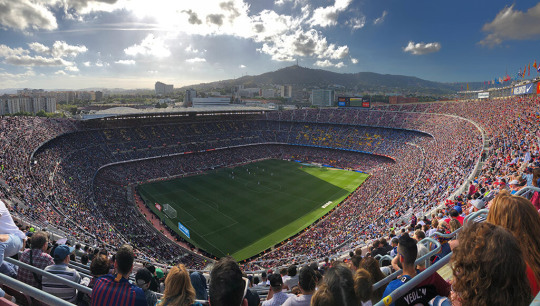
Live the Camp Nou experience
The Futbol Club Barcelona or Barça, is the joy and pride of most Catalans who passionately live this sport. The home of FC Barcelona is the Camp Nou, inaugurated on September 24, 1957. It is the largest stadium in Europe, with a capacity for 99,354 spectators. If you leave Barcelona without going through the Camp Nou, you better never say so. Taking a walk around the stadium is a must-see even if you are not so fond of sports.
Savor a great Calçotada
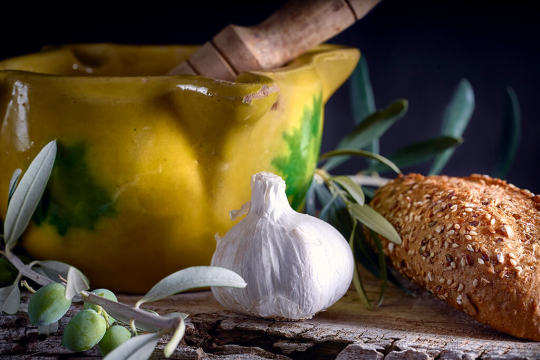
yellow-mortar-make-sauce-called-allioli-typical-catalonia-spain
It is a typical festival of Catalonia that you can witness if you are there between the months of January and March. It is a gastronomic tradition in which calçots are eaten, a variety of onion that is grown especially for this celebration. The vegetable is roasted directly over flames and eaten garnished with a nut-based sauce called salvitxada. The embers are then left alight to grill meats or sausages and accompany everything with good wine.
Gothic Quarter
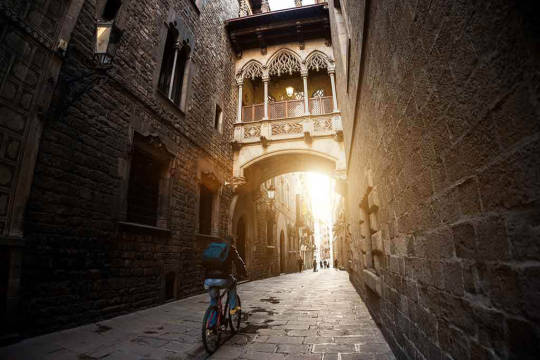
Gothic Quarter
It is one of the oldest neighborhoods in the city and also one of the most visited due to its medieval charm. It is the most prominent place in the old town of Barcelona. Thousands of tourists enter its narrow streets where there are also a large number of bars, restaurants and shops.
In this neighborhood, there are many places to visit, for example, the Cathedral of Santa Eulalia, the Plaza Sant Jaume (political center of Barcelona), Carrer del Bisbe, the Plaza Real that is next to the famous Las Ramblas street. There are also other places of interest such as the Plaza del Rey (seat of the Royal Palace), Calle Portal de L’Angel, the Frederic Marès Museum and the remains of the Jewish Quarter (known as El Call).
Catalan music palace

Catalan music palace
The Palace of Catalan Music is located on Sant Pere més Alt street, in the Ribera neighborhood. It is a music auditorium that is part of the most illustrious works of the architect Lluís Domènech I Montanerque. The building represents Catalan modernism’s best, and its construction was carried out between 1905 and 1908. Unesco declared it a National Monument in 1971.
Entering this room is to immerse yourself in a very honest artistic magic, ideal to enjoy any musical style. The acoustics is one of the best in the world, and both the interior and exterior have an elegance that falls in love.
National Museum of Art of Catalonia

Spain square or Placa De Espanya in the golden hour at sunset, with the National Museum, in Barcelona, Spain
The National Museum of Art of Catalonia (MNAC) is inside the National Palace of Montjuïc that was built for the International Exhibition of 1929. But it was not until 1934 that the museum opened its doors exhibiting the medieval collection. Today this cultural space has many important collections, but the most outstanding is that of Romanesque art, which is even considered one of the most complete in the world.
The MNAC also has a very comprehensive library that specializes in art history and is a reference for both professionals and art history enthusiasts.
Arc de Triomphe in Barcelona

triumphal arch in night. Barcelona, Spain
Contrary to what many people may think, this triumphal arch was not built to commemorate a military victory. On the contrary, it is a monument that commemorates art and progress, it was designed by the architect Josep Vilaseca I Casanovas on the occasion of the first Universal Exhibition of Barcelona that took place in 1888.
It consists of a classic-style structure with decorative finishes with different meanings. It is 30 meters high and has an inscription that says “Barcelona rep les nacions” (Barcelona receives the nations). The Arc de Triomphe can be admired from different points of the city, but it is found specifically on the Paseo de Lluís Companys. This is a very popular place for locals and tourists who cannot ignore the greatness of this Catalan Cultural Heritage.
Picasso Museum of Barcelona
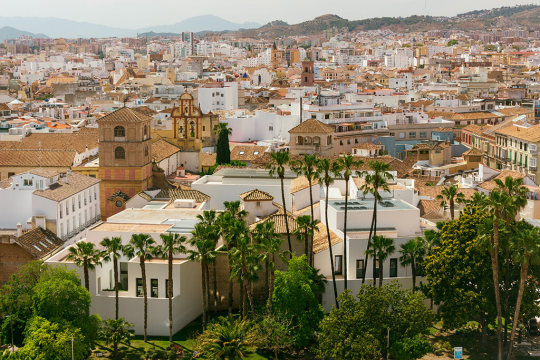
malaga picasso museum
The Picasso Museum is one of the most important and prominent museums in Barcelona, it is located on Calle Montcada. It brings together more than 4,000 pieces by the artist, including drawings, sculptures, paintings and engravings. The museum was created by the will of Picasso himself, his friend Jaume Sabartés collaborated with this idea, until finally, in 1963, the museum opened its doors to the public.
Inside the enclosure it is possible to admire a vast collection of works by the famous painter , among which are “Portrait of Aunt Pepa”, “Man with a beret”, “Science and charity”, “The hug” and “The divan”.
The Barceloneta
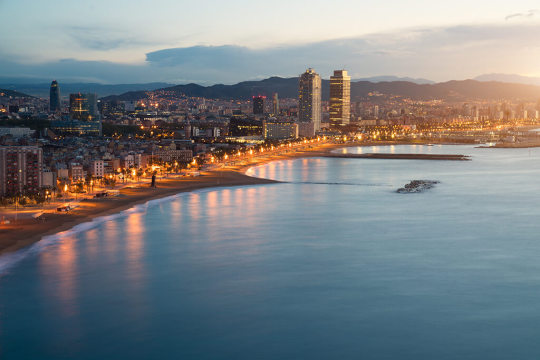
Aerial view of Barcelona Beach in summer night along seaside in Barcelona, Spain. Mediterranean Sea in Spain.
In 1754 fishermen began to settle near the sea and populated what is now known as Barceloneta, one of the neighborhoods most appreciated by locals and tourists. It is an ideal place to enjoy with the family.
Among its narrow streets, you can take a pleasant walk and taste fresh fish that are served in the establishments in the area. At Barceloneta Beach, take the cable car to get to the Miramar de Miramar, from where you can enjoy a beautiful landscape.
La Boqueria
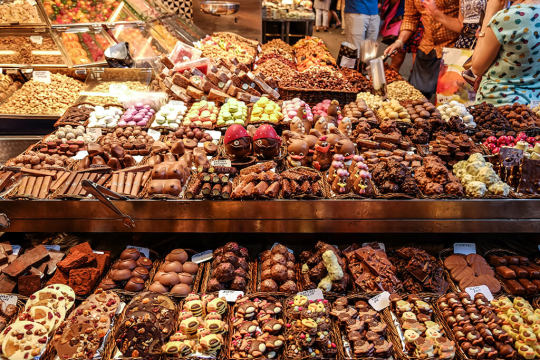
La Boqueria
It is actually called Mercado de San José, it is located on the Rambla and was inaugurated in 1840. However, its outdoor origins are much older in fact, it is believed that this is one of the oldest markets in Europe.
In the Boqueria, there are more than 250 stalls where you can find all kinds of fresh and exotic food, as well as bars and restaurants. Colors and numbers organize the posts. Make sure you get through it completely, even if it is a bit strenuous, it is worth the tour. One of the most popular places in this market is Bar Pinotxo.
The Spanish town

Placita de la Boqueria and Bruno Cuadros house with umbrellas in Barcelona, Catalonia, Spain
It was built in 1929 on the initiative of the architect Josep Puig I Cadafalch . The reason was the International Exhibition that would be held that same year in Barcelona. The idea was to reproduce, in a single space, all the characteristics of a traditional Iberian town . In this way, the architecture and cultural roots of Spain were exposed. The idea was to tear it all down once the event ended, but its great popularity did not allow this to happen.
Visiting El Pueblo Español is like going to an open-air museum . There you can see all kinds of architecture, artisan workshops, gastronomic walks, churches, squares and very picturesque streets. This, without a doubt, is one of the must-see places in Barcelona.
Cultural tourism in Barcelona
Without a doubt, in Barcelona historical tradition and the avant-garde are perfectly combined. Really enjoy this wonderful city, don’t be the typical superficial tourist. Travel and know not only its famous places, but also the interesting history behind them. Live the magic of an unforgettable cultural experience in Barcelona.
from WordPress https://ift.tt/3tlCPSG
via IFTTT
0 notes
Photo

The Cathedral of the Holy Cross and Saint Eulalia (Catalan: Catedral de la Santa Creu i Santa Eulàlia), also known as Barcelona Cathedral, is the Gothic cathedral and seat of the Archbishop of Barcelona, Catalonia, Spain. The cathedral was constructed from the thirteenth to fifteenth centuries, with the principal work done in the fourteenth century. The cloister, which encloses the Well of the Geese (Font de les Oques) was completed in 1448. In the late nineteenth century, the neo-Gothic façade was constructed over the nondescript exterior that was common to Catalan churches. The roof is notable for its gargoyles, featuring a wide range of animals, both domestic and mythical. The cathedral is dedicated to Eulalia of Barcelona, co-patron saint of Barcelona, a young virgin who, according to Catholic tradition, suffered martyrdom during Roman times in the city. One story says that she was exposed naked in the public square and a miraculous snowfall in mid-spring covered her nudity. The enraged Romans put her into a barrel with knives stuck into it and rolled it down a street (according to tradition, the one now called Baixada de Santa Eulàlia). The body of Saint Eulalia is entombed in the cathedral's crypt. ⛪️ 📸 🍀 #Travel #TravelPics #Photography #TravelPhoto #Podroze #Wycieczka #Zdjecia #Catalonia #Spain #barcelona #visitspain #visitcatalunya #visitcatalonia #visitbarcelona #Autumn #Sun #Fun #Follow #FollowMe #FollowThem #Walk #Walking #barcelonacathedral #barcelonacathedral⛪️ #barcelonacatherdral (w: Catedral De Santa Eulalia Barcelona) https://www.instagram.com/p/CJUOJCSHvGQ/?igshid=11al79yopxtif
#travel#travelpics#photography#travelphoto#podroze#wycieczka#zdjecia#catalonia#spain#barcelona#visitspain#visitcatalunya#visitcatalonia#visitbarcelona#autumn#sun#fun#follow#followme#followthem#walk#walking#barcelonacathedral#barcelonacathedral⛪️#barcelonacatherdral
0 notes
Photo

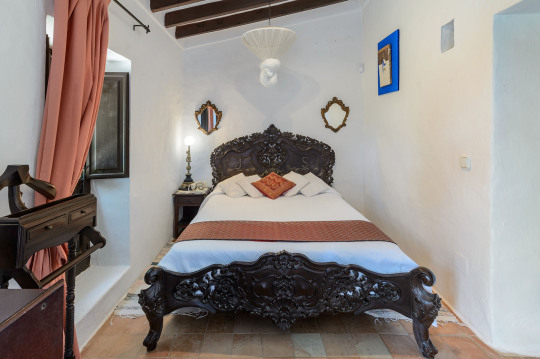

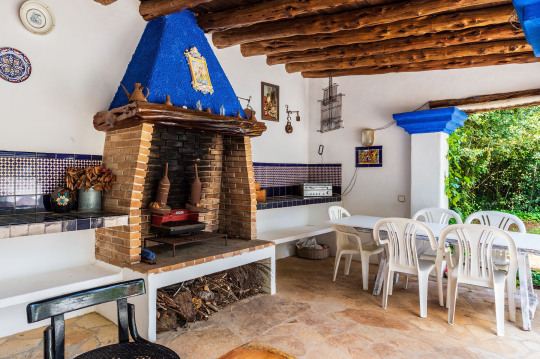





Traditional ibicenco country house located in the quiet countryside between the quaint village of San Carlos and Santa Eulalia. This charming old finca is made up of three separate buildings, the main house which is the oldest part of the house and two smaller guest houses. The living room with log fire and the integrate window in the ceiling is ideally for the evenings together. The open dining space with the kitchen and door directly to the garden brings enough room and an open living flair. The main house has 3 bedrooms. The master bedroom owns the whole first floor. Additional to that there are two guest houses, which each of them has a own bathroom, a living area with a small integrate kitchen and a private terrace. Perfectly suitable for befriended couples or families with children. The property has a large pool and extensive terraces for lazy afternoons and sunbathing. There are numerous shaded areas and pergolas as well as on outdoor BBQ area near the pool which gives you the perfect shadow spots during the heat on Ibiza. This is a very child friendly villa as the pool has a shallow beach end and sits, as well as a dining table intergrate into the water. The exteriors and gardens have mature plants and palm trees and offer a completely private and peaceful environment for a relaxing holiday. The villa is a short drive to the nearby supermarkets of Santa Eulalia and the nearby family friendly beaches of Cala Nova, Cala LLenya and Niu Blau.
More Infos and photos:
https://www.ibiza-selected.com/villa-casa-pages/
0 notes
Text


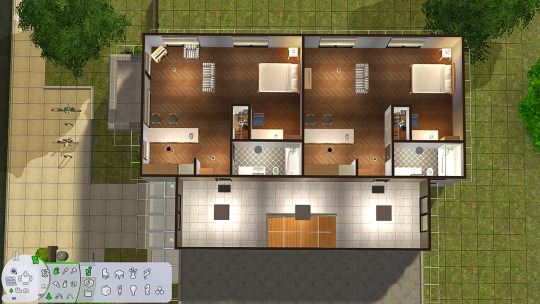
I wanted a studio apartment to move Louise into after her Mandatory Freshman Dorm Stint, so I slapped this together based off a plan that popped up when I searched 'studio apartment floorplan'. I think it'll work really well for the uni students!
132 notes
·
View notes
Text
Oh, God, it’s the 10 questions meme again!
@eulaliasims tagged me. It’s her fault! :) This is the one where you answer the 10 questions from the person who tagged you, then you make a list of 10 questions for 10 people you tag to answer. (Mine are silly, as usual, and not Sims-related because I’m that way. :) )
I cut, because as usual I babble, but here’s my tag list for my questions above the cut. Because I am lazy, I tag the last 10 folks who have an active Tumblr and who left me a note on a post, as of the time I'm writing this, so:
@annegirl13, @wiksims, @littlemicrocosims, @simblrkersil, @savannahsimslover, @acquiresimoleons, @knightcommanderalenko, @emperorofthedark, @holleyberry, and @drudragonrose. (But as always, feel free to completely ignore if this isn't something you want to do for whatever reason. No pressure at all! :) )
Eulalia’s questions answered:
If you like to decorate in the Sims, what’s your favorite type of room to do? If you don’t, how do you handle decorating instead? Bare minimum? Downloading furnished lots?
I actually don't really like decorating, at least not the inside of houses. Build, yes; decorate, no. I do like decorating exteriors, though. So, for me, I usually do not much above the bare minimum for interiors, and I pretty much do the same things all the time so that A) I don't have to think about it much and B) I can keep down the CC level somewhat. I certainly can't be bothered with clutter and all that. That said, I do like to do kitchens and somewhat decadent master bathrooms, probably because those are my favorite real-life rooms, too.
Do you like to listen to anything like music or podcasts when you play?
Not while I play, no. I like to hear the sound effects like ringing phones and the sounds of Sims getting hearts and the sounds of Sims getting busted for cheating and the sounds of stuff breaking. But if I'm building or creating stuff, I'll usually have a TV show or movie playing in another window or on the second monitor I have. That's one of the good things about having a large monitor. But sometimes if I don't feel like having a show playing in the background, I'll put on Spotify and listen to whatever sort of music I'm in the mood for.
What made you choose your first expansion pack for the game (or games, if you play more than one iteration of the Sims)?
I suppose technically the first EP I got was Nightlife because when I started playing -- which was in January of 2008, I think, because I know it was a little before Freetime was released because I remember seeing the signs for Freetime in Walmart -- I downloaded Deluxe from EA before the whole "Origin" thing existed. Deluxe was the base game plus Nightlife, so Nightlife was my first expansion. I don't think that really counts, though, because I didn't pick it and probably wouldn't have picked it if I'd had a choice because it's one of my least-favorite EPs. It was just all that was available for download at the time. So the first "real" EP I got in the sense that I chose it was Seasons. It was on sale for $10 at Walmart when I was there like a week after I got the game, so I bought it. So, "it was available and on sale" was the main reason I got it," but I probably would've picked it anyway for the gardening.
What’s your favorite kind of weather?
Cool/cold but sunny and crisp weather. I can't wait to go home to Colorado in November. :D
What’s the first ever music album you remember buying?
The Moody Blues's Days of Future Passed. I got it a couple years after it was released; I think I was 5, so it would’ve been in 1969. I more or less immediately started picking out “Tuesday Afternoon” on the piano once I could listen to it whenever I wanted. It's still in my Top 5 favorite albums. I love prog/psychedelic rock, specifically, and concept albums in general.
Do you prefer default townies, custom townies, or no townies at all? (Or maybe default and custom?)
Either default or none at all. I go back and forth. When I get tired of the defaults, the empty Pleasantview template goes in. I've never felt a need to mess around with custom townies. At most, if I want townies and I don't have the default ones, I let the game generate a batch of townies. I don't bother with making them myself. But then, I don't generally make Sims, period, so...
Why is your favorite book your favorite?
Because it's historical fiction (my favorite genre) with minimal anachronism and not romanced-up. Believe me, that kind of thing is hard to find, especially the not-romanced-up part. I mean, if I want to read about people having sex, I'll read some (good) erotica. I don't want to read "romance" books. :P
What’s the latest song/jingle to get stuck in your head?
The Ride of the Valkyries. I started humming it the other day when I was cooking, and I haven't been able to get it out of my head since. And I hate Wagner with the fiery fire of ten thousand burning suns, so I have NO idea why I started humming that damn thing. Make it stop!
What object (CC or not) do you use the most in your game?
Buggybooz's kitchens, I think. They're simple, and I have lots of recolors for them.
My questions, for my tag-ees to answer:
1) Chocolate: Dark, milk, white, or no, thank you?
2) How far is it to the nearest grocery store from your house/apartment?
3) How many house plants are in your house/apartment?
4) What color are the towels in your bathroom? (Or the bathroom you use most, if you have more than one.)
5) Your preferred brand of toilet paper? (No, really! I want to know!)
6) Do you wear socks? If so, what kind?
7) Are you afraid of flying? How 'bout in really small planes?
8) Do you like to cook? If so, what's your signature dish?
9) Are there popcorn ceilings in your house/apartment?
10) The beach: Love it, like it, indifferent, or hate it? Or something else?
16 notes
·
View notes
Text

Sachiko extrañaba la casa, desde luego, pero probablemente lo que no la dejaba dormir era el extremo cansancio. Se había levantado temprano, la habían zarandeado y baqueteado en tren y automóvil con todo el calor del día y por la noche había corrido los campos con los niños, tres o cuatro kilómetros por lo menos... Con todo estaba segura que sería bonito recordar la caza de luciérnagas. Sólo había visto tal cosa en el teatro de títeres: Miyuki y Komazawa susurrándose amores mientras navegaban río Uji abajo. Y desde luego había que vestir como cuadraba: quimono de rozagantes mangas, con un elegante motivo de verano, y correr por los campos con las mangas al viento, prendiendo con delicadeza de tanto en tanto una luciérnaga de debajo del abanico. Sachiko estaba embelesada con el cuadro. Pero de hecho una caza de luciérnagas era algo muy distinto. Les dijeron que si iban a salir a corretear por el campo era mejor que se cambiaran, y les sacaron cuatro quimonos de muselina, quizá especialmente dispuestos para ellas, cada uno con un diseño diferente, según correspondía a sus diferentes edades. «¡Nada que ver con las estampas!», dijo entre risas una de las hermanas. Casi era de noche después de todo, poco importaba lo que llevaran puesto. Cuando salieron de la casa todavía distinguían sus rostros entre sí, pero para cuando llegaron al río era prácticamente noche cerrada. Lo llamaban río, pero en verdad era poco más que una reguera entre los arrozales, algo más ancha quizá de lo normal, con penachos de eulalia inclinados en ambas márgenes, casi tapando la corriente. Aún se columbraba un pontezuelo a un centenar de metros.
Apagaron sus linternas y se acercaron en silencio. A las luciérnagas les molesta el ruido y la luz. Pero ni siquiera en la misma orilla había ninguna. «Igual no han salido esta noche», dijo alguien. «No, hay muchísimas. Venid por aquí.» Abajo en las hierbas de la ribera, en el sutil instante cuando se extingue el último resplandor, estaban las luciérnagas, rasando el agua en arcos, al vaivén del herbazal... Y aguas abajo, sin fin, sartas de luciérnagas ondulaban desde ambas márgenes, yendo y viniendo... trazando sus difusas líneas luminosas a flor de agua, ocultas del exterior por las altas hierbas... Sachiko lo seguía viendo, acostada con los ojos cerrados. En el postrero fulgor, entre la lobreguez que emanaba del agua y los plumeros que se mecían vagamente silueteados, allá, por todo el largo cauce, un número infinito de breves trazos de luz en dos largas bandas, mudas, irreales. Sin duda fue el apogeo de la noche, el momento que hizo que la excursión valiera la pena. Una caza de luciérnagas no tenía en absoluto la brillantez de una gira para ver los cerezos en flor. Era más bien, digamos, sombría, ensoñada. Tenía algo de la fantasía de la infancia, del mundo de los cuentos de hadas... Algo trasladable a la música, más que a la pintura, cuya atmósfera podía quizás captar el piano o el koto. Y mientras yacía con los ojos cerrados, las luciérnagas seguían guiñando sus luces a todo lo largo del río, toda la noche, calladas, infinitas. Sachiko sintió un arrebatado ímpetu, como si se uniera a ellas flotando y calando sobre la haz del agua, trazando su propia estela de luz.
Habían recorrido un gran trecho, ahora que lo pensaba, siguiendo el riacho tras las dichosas luciérnagas. De vez en cuando cruzaban una pasarela, cambiando de ribera, con cuidado de no caerse, pendientes de las serpientes, de sus ojos que fulgen igual que las luciérnagas. Sōsuke, el chico de seis años de Sugano, abría la marcha en la tiniebla, pues conocía al dedillo el terreno, y su padre, que las guiaba, lo llamaba inquieto: «¡Sōsuke, Sōsuke!». Ya nadie se preocupaba de si espantaban a las luciérnagas: había tantas... Además si no se llamaban entre ellos, corrían el riesgo separarse en la oscuridad, cada uno siguiendo por su lado a sus luciérnagas. En un momento Sachiko y Yukiko se quedaron solas en una orilla y desde la opuesta llegaban voces, ya claras ya emborronadas por el viento, llamando: «¡Madre!... ¿Dónde está madre?... Por aquí... ¿Y Yukiko?... Está aquí conmigo... Yo tengo ya veinticuatro... ¡No te vayas a caer al agua!».
Sugano arrancó alguna hierba por el camino e hizo un atadillo como una escoba: «Para guardar las luciérnagas», dijo. «Hay sitios famosos por sus luciérnagas como Moriyama en Omi, o los arrabales de Gifu, pero están acotados para la gente importante. Aquí a nadie le preocupa cuántas cojas.» Y Sugano atrapó más que nadie. Padre e hijo bajaban atrevidamente hasta el mismo borde del agua y la escoba de Sugano se enjoyó de luces. Sachiko y las otras empezaron a preguntarse cuándo daría por terminada la partida. «El viento es frío; quizás sea hora, ¿no le parece?» «Pero si ya vamos de vuelta, sólo que por otro camino.» Siguieron caminando, habían ido más lejos de lo que pensaban. Y de pronto estaban ante la puerta de atrás de casa de Sugano, cada uno con sus pocas luciérnagas; Sachiko y Yukiko con algunas en las mangas...
Los acontecimientos de la velada se sucedían sin orden en la mente de Sachiko. Abrió los ojos: quizás lo había soñado. Sobre ella, a la luz de la diminuta bombilla, podía ver un cuadro enmarcado en el que ya se había fijado el día anterior: tenía escrito en grandes caracteres Pabellón de la Intemporalidad, firmado por un tal Keidō. Sachiko contempló las palabras sin saber quién sería Keidō. Una centella cruzó la habitación contigua. Espantada por el incienso contra los mosquitos, una luciérnaga estaba buscando la salida. Habían soltado sus luciérnagas antes en el jardín y muchas se metieron en la casa. Pero las ahuyentaron metódicamente antes de cerrar las puertas para dormir. ¿Dónde habría estado aquélla escondida? Con un postrero arranque de energía voleteó un par de metros y luego planeó agotada por la habitación, yendo a posarse en el quimono de Sachiko, colgado en el galán. Se movió por el estampado y entró por la bocamanga, brillando tenue a través de la fina tela gris azulada. El incienso del pebetero en forma de tejón estaba empezando a agarrársele a la garganta a Sachiko. Se levantó a apagarlo y ya que estaba se acercó a ver la luciérnaga. La recogió con cuidado en un pedazo de papel, porque tocarla le daba repelús, y la sacudió fuera por una ranura del postigo. El jardín estaba negro como laca. De las docenas de luciérnagas que latían antes entre las matas y por la orilla del estanque no quedaba casi ninguna. ¿Habrían vuelto al río?
Tanizaki Jun'ichirō
2 notes
·
View notes
Text
'Memoria histórica', la mostra que revisa els conceptes de memòria i història | Imaginart | 31 oct.
Inauguració: 31.10.2019 a les 19: 00h
Exposició: del 31 d'octubre al 29 de novembre de 2019
Artistes: Rosa Amorós, Victoria Campillo, Colita, Charles Fréger, Ferran García Sevilla, Jordi Font Recasens, Toni Molins, Santiago Sierra i Eulalia Valldosera
MEMÒRIA HISTÒRICA és un projecte que revisa els Conceptes memòria i història a partir dels Treballs de Rosa Amorós, Victòria Campillo, Colita, Charles fregit, Ferran García Sevilla, Jordi Font Recasens, Toni Molins, Santiago Serra i Eulàlia Valldosera. Una exposició comissariada per Victor Cortina.
Memòria i història són dos conceptes que ens són familiars i que tenim, en principi, assimilats, però que ambdós es presten a manipulacions, interpretacions i visions múltiples. A vegades interessades, les que més, sovint deformades i en general susceptibles a ser revisades periòdicament. La memòria, constituïda pels nostres records, és una base de dades, en la qual no existeixen carpetes, sinó capes de sensacions, imatges i seqüències incompletes, que ens agrada recuperar, intuïtivament, per a assaborir-les, i racionalment confrontar-les amb la realitat actual per establir comparacions i prendre decisions. Hi ha diversos tipus de memòria, entre ells, la memòria declarativa (o explícita): conté els fets del món i els esdeveniments personals del passat que és necessari recuperar de manera conscient.
La memòria episòdica: conté la informació relativa a successos esdevinguts en un moment i un lloc determinats i la memòria de referència: conté la informació recent i remota obtinguda a partir de les experiències prèvies. La història, en canvi, és una ciència, que té com a objectiu estudiar els successos del passat i per dir-ho així, la memòria col·lectiva. Per tant, història i memòria són conceptes complementaris; hardware i software, utilitzant una metàfora informàtica. La memòria històrica ens permet reavaluar els nostres records, visitar-los de nou i posar-los sota el prisma de l’actualitat.
Les “Vanitas” en ceràmica de Rosa Amorós expliciten el que més defineix el nostre llegat físic, el crani, vestigi d’allò que vam ser i allò que pensem en vida. Els objectes també tenen records, com suggereix l’obra “Balls”, pilotes que algú, potser els artistes que Victoria Campillo suggereix i ficciona, van comprar, van fer servir i van abandonar finalment, a qualsevol racó, com a cadàvers insepults, d’un sol ús i oblidades. Tenen les seves vivències(sic), marques i ferides a la pell, que ens revelen qui les va trepitjar, fins a deixar-les inservibles.
La música historiada, degudament documentada per la seva pertinença a les Arts Majors, i als seus protagonistes històrics, aquells que van deixar la seva petjada en la història del flamenco, com Paco de Lucía, Peret o Carmen Amaya, apareix en els inoblidables retrats de Colita. Música i memòria. Els codis de la vestimenta vénen marcats per la memòria de les modes, dels oficis o dels costums ancestrals, com en Charles Fréger, que en la seva sèrie “Wilder Mann”, explora antigues litúrgies, en les que disfressant-se d’animal o de dimoni, s’intenta connectar amb unes arrels pretèrites i màgiques. Hi ha quelcom més pretèrit en la nostra memòria que el moment en què la raça humana es va dedicar a la ramaderia i a la transhumància.
Les fotografies de Jordi Font Recasens, antropòleg d’una activitat de pasturatge, que hem desenvolupat des de l’origen dels temps. Ferran García Sevilla i la desmemòria. En la seva pintura construïda sense pintar, l’artista travessa maneres i significats sense aturar-se en cap d’aquests, fruit d’aquella voluntària desmemòria a la qual s’obliga a si mateix i d’aquella experimentació momentània amb trossos d’història i amb els sentits transformables de les coses, amb el fi de crear noves ficcions, nous flaixos, nous nuclis d’energia des d’on emetre alguna aproximació renovada cap al món (Teresa Blanch).
D’una manera diferent, encara que coincident en allò desmitificador i també des de la pintura, Toni Molins recupera personatges històrics: Mahler, Rile o Rimbaud, per afegir una interpretació inesperada a allò que sabem o pensem d’ells. Santiago Sierra, que fa una revisió de la història en el present, per negar una versió oficial, tergiversada i creada per aquells que posseeixen un poder, sovint fosc i gairebé sempre tendenciós. Eulàlia Valldosera amb les seves ampolles treballa amb la memòria d’una manera catàrtica. Són envasos intervinguts - o pervertits- convertits en dispositius tàctils, visuals o sonors. Tot objecte amb el qual establim relació es transforma en un dispositiu que adquireix i arxiva la nostra memòria. Són perversos perquè la seva aparença exterior no ha canviat, però quan els toquem sentim les veus que ens relaten situacions. Són fragments d’entrevistes de persones que han viscut situacions d’humiliació.
IMAGINART GALLERY
Avda. Diagonal 432 | 08037 Barcelona, catalunya
www.imaginart-gallery.com
.
.
https://1.bp.blogspot.com/-7V7H3Ph3vxM/XbLcDWcq9WI/AAAAAAAAB4w/7uu1ERvXR_EB01n96gEpNhM2TIQrecYUgCLcBGAsYHQ/s640/unnamed%2B%25283%2529.jpg http://www.artneutre.net/2019/10/memoria-historica-la-mostra-que-revisa.html #Art #Catalunya #Barcelona #PaisValencià #Balears #Andorra #Occitània #Alguer #AgendArt #Valencia #Palma
0 notes
Text
Hoteles en Santa Eulalia – Ibiza
Hotel Fenicia Prestige Suite&Spa
Hotel situado junto al río de Santa Eulalia, a unos pasos de la playa de Santa Eulalia. El hotel dispone de restaurante Oriental Monsoon, “Puig de Missa” grill restaurante, restaurante Buffet Fenicia, conexión a Internet, piano bar, bar salón, bar piscina, piscina con jacuzzi, rodeada de amplias terrazas y suntuosos jardines y SPA.
Hotel Sol S´Argamassa
Hotel situado en primera linea de mar, junto a la playa. A 100 mts. de Cala Martina. A 1,5 kms. del centro turístico Es Cana. El hotel dispone de restaurante con buffet de desayuno y cena así como show-cooking (cocina en vivo), piano bar, dos piscinas exteriores ambas con sección para niños.
Hotel Tres Torres
Hotel situado en la Bahía Ses Estaques en Santa Eulalia del Río. El hotel dispone de restaurante buffet de la dieta mediterránea, bar piscina con terraza, terraza solarium, piscina.
Hotel Goleta
Hotel situado en primera línea de la Playa d’en Bossa. El hotel dispone de bares, restaurante, snack bar, cuatro salas de conferencia, piscina exterior para adultos, piscina exterior para niños, piscina interior climatizada, parque infantil.
Hotel Tres Carabelas
Hotel situado en primera línea de la Playa d’en Bossa. El hotel dispone de bares, restaurante, snack bar, cuatro salas de conferencia, piscina exterior para adultos, piscina exterior para niños, piscina interior climatizada, parque infantil.
Hotel Santa Eulària
Hotel situado directamente sobre el mar y a 800 m de la playa. El hotel dispone de Wellness y Fitness Spa, piscina y piscina infantil, tenis de mesa, billar, bufet de desayuno, cena con bufet frío y caliente, cocina en vivo, bar salón con terraza y servicio de snack.
Hotel Seaview Contry
Hotel situado a 100 metros de la playa Port d’es Torrent. El hotel dispone de dos bares, restaurante, snack bar, piscina exterior para adultos, piscina exterior para niños, jardines, parque infantil, sala de juegos para niños.
Hotel Club Playa
Hotel situado en Cala Llonga, Santa Eulalia, a 50 metros de la playa. El hotel dispone de bares, restaurante, snack bar, piscina exterior para adultos, piscina exterior para niños. jardines, parque infantil, sala de juegos para niños, tenis de mesa.
Hotel Sol Ibiza
Hotel situado Junto al mar, en una zona tranquila de Sta. Eulalia, rodeado de jardines. A 300 mts. del puerto deportivo. El hotel dispone de buffet de desayuno, restaurante buffet, restaurante con servicio de show-cooking (cocina en vivo) y rincón italiano, bar restaurante piscina, piano bar, piscina cubierta, gimnasio, jacuzzi, baño turco, sauna o rayos UVA.
Hotel Club Siesta
Hotel situado en Santa Eulalia, en la Urbanización Siesta, a 500 metros de la playa. El hotel dispone de bares, restaurante, snack bar, piscina exterior para adultos, piscina exterior para niños. jardines, parque infantil, sala de juegos para niños, gimnasio, minigolf.
Hotel Coral Playa
Hotel situado en Es Canar, Santa Eulalia, a 200 metros de la playa. sus habitaciones están completamente equipadas y con aire acondicionado. El hotel dispone de bares, restaurante, snack bar, piscina exterior para adultos, piscina exterior para niños. jardines, parque infantil, sala de juegos para niños.
Hotel Playa Dorada
Hotel situado en Cala Llonga, Santa Eulalia, a 20 metros de la playa. El hotel dispone de bares, restaurante, snack bar, piscina exterior para adultos, piscina exterior para niños. jardines, parque infantil, sala de juegos para niños, tenis de mesa, billar.
Hotel Panorama II
Hotel situado en primera línea de la playa Es Caná en Santa Eulalia del Rio. El hotel dispone de restaurante a la carta, terraza solarium, piscina, piano bar, pista de tenis y parque infantil.
Hotel Panorama I
Hotel situado en primera línea de la playa de Es Canà en Santa Eulalia del Rio. El hotel dispone de restaurante a la carta, terraza solarium, piscina, piano bar, pista de tenis y parque infantil.
Hotel Miami
Hotel situado sobre la magnífica playa de Es Caná. El hotel dispone de restaurante buffet climatizado, barbacoa al aire libre, Bar-Salón, Bar-Piscina, bajada directa a la playa. Piscina para adultos, piscina para niños, parque infantil.
Aparthotel El Pinar
El aparthotel se encuentra situado en la tranquila playa de Cala Llonga, situada a 5 km de Santa Eulalia, sus apartamentos están completamente equipados y con aire acondicionado. El aparthotel, dispone de: bar-restaurante con una magnífica terraza con vistas al mar, una amplia carta, piscina con solarium, pista polideportiva y un parque infantil para los más pequeños.
Hotel Ses Estaques
Hotel situado en primera línea de mar próximo a una de las ciudades más importantes y bellas de Ibiza, Santa Eulària des Riu. El hotel dispone de restaurante buffet, un restaurante a la carta junto al mar, una magnífica terraza con jardín, piscina, bar, solarium y dos jacuzzis, mini golf, tenis, ping-pong, billar.
Hotel Playa Imperial
Hotel situado en Cala Llonga, Santa Eulalia, a 20 metros de la playa. El hotel dispone de bares, restaurante, snack bar, piscina exterior para adultos, piscina exterior para niños. jardines, parque infantil, sala de juegos para niños.
Hotel Cala Llonga
Hotel situado junto al mar y rodeado de pinares, en la ladera de una montaña y a pocos metros de la tranquila cala que le da nombre, Cala Llonga. El hotel dispone de restaurante tipo buffet con platos de cocina internacional, restaurante con terraza, dos bares, piscina situada junto al mar con solarium, jardines y terrazas que bajan directamente al mar, pista de tenis y de voleibol.
Hotel La Cala
Hotel situado en el centro turístico, a tan solo 50 metros del Puerto Deportivo y del Paseo Marítimo y 250 metros de la playa de Santa Eulalia del Río. El hotel dispone de bar-cafetería. restaurante con servicio buffet. piscina con solárium.
Hotel Cala Nova
Hotel situado en una zona tranquila, rodeada de pinos, frente de la isla de Tagomago. En las proximidades se encuentra Es Canar. El hotel dispone de restaurante tipo buffet con cocina en vivo “Show Cooking”, dos bares: uno situado en el lobby y otro en la zona de la piscina con servicio de snack. Salón social, dos piscinas circulares una de ellas especial para los niños, terrazas solarium, miniclub y parque infantil, pista polivalente de deportes.
Hotel Don Carlos
Hotel situado a sólo 50 m del mar, a 2 Km del pueblo de Santa Eulalia y a pocos kilómetros del pueblo de Es Canar. El hotel dispone de restaurante buffet con cocina en vivo “Show cooking”, tres bares: uno situado en el lobby, otro en la zona de piscina y el tercero junto al mar, piscina con zona separada para los niños, terrazas solarium.
Hotel Atlantic
Hotel situado en Es Canar, a 300metros de la playa. El hotel dispone de bares, restaurante, snack bar, piscina exterior para adultos, piscina exterior para niños, jardines, parque infantil, sala de juegos para niños.
Hotel Ereso
Hotel situado en el centro turístico de Es Canar, a tan sólo 200 metros de la magnífica playa de Es Caná. El hotel dispone de bar, restaurante con servicio buffet, dos piscinas con solárium, parque infantil, amplias terrazas y jardines con pinos y palmeras.
Hotel Caribe
Hotel situado en una zona tranquila de Ibiza en Es Canar. El hotel dispone de terraza solarium con piscina para adultos y piscina infantil separada, parque de juegos infantil, pista polideportiva, ping pong y mesas de billar, bar restaurante con servicio de terraza.
Hotel Riomar
Hotel situado a 10 metros de la playa, con vistas al Mar y a la montaña, se encuentra ubicado en la población de Santa Eulàlia des Riu. El hotel dispone de comedor buffet para el desayuno y la cena, al estilo más internacional, restaurante buffet, barbacoa al aire libre, bar-salón, bar-piscina, bajada directa a la playa. piscina para adultos, piscina para niños.
La entrada Hoteles en Santa Eulalia – Ibiza aparece primero en - Visitando España.
from – Visitando España http://bit.ly/2HxfXuq
0 notes
Video
youtube
Ecuador ha acogido a 250 mil venezolanos Ecuador, país vecino de Venezuela, ha acogido a cerca de 250 mil refugiados que han solicitado ingresar al país huyendo de las condiciones adversas que dominan en aquella nación. María Eulalia Silva, directora de Comunicación del Ministerio de Relaciones Exteriores y Movilidad Humana de Ecuador, rev... SUSCRIBETE ES GRATIS!! https://www.youtube.com/channel/UCiFBDYHiRQ5ph4nGKYhyIQg?sub_confirmation=1 SUSCRIBETE para no perderte nada, aqui seguiremos activos Dando a conocer mas de HUNI News , deja tu comentario y tu like, nos motiva a seguir adelante Hasta la Proxima!! #Ecuador #ha #acogido #a #250 #mil #venezolanos
0 notes
Text
“Casa particular” literally means “private house” but it started to be used to mean “private accommodation” in 1997, when the Cuban government allowed Cubans to rent out rooms in their houses or apartments to tourists, providing Cuban families with new sources of income.”
The downfall of the Soviet Union resulted in tremendous financial hardship for Cuba. The subsidies they had been receiving (a large part of their budget) were literally cut to zero, thus adjustments for basic survival were needed to their economic strategies. Part of the turn-around plan called for an increase in tourism. To address the problem of limited hotels to accommodate the projected visitation, local folk were granted permission to obtain a license to transform rooms in their residence to rental units. Thus, the casa particular boom was created.
Tourist have been flocking to Cuba for years. The notion of seeing 1950’s American cars troll the streets has its own fascination. Then there are the iconic cigars or the rum or the music, just to name a few cultural distinctions. For many Americans, the yearn to visit Cuba has been increasing each year. However, for some, they are stuck on Fidel Castro and his regime and have disdain of ever visiting or “coming home.” They view any suggestion on visiting the island as a compromise to their way of life.
The merits of the conflict are worth pursuing, if nothing more than to give you a better perspective but for those like me, it’s the real people who live everyday lives which are more important than political ideology. So, out of respect many appreciate the feelings of those who hold unto the “anti-Castro” sentiment as the bigger picture is many of the 11 million people of Cuba have a thirst for you to visit their country.
You can find casa particulars all over the country. Some can be booked online through sites such as Airbnb, TripAdvisor, Expedia, etc. At the same time, some do not wish to pay the fees associated with having their property listed so once you find their email address or phone number, communication is no problem.
If you desire is to truly experience everyday Cuban life, you will find casa particular a great choice. In addition to being a “guest” in somebody’s home, you will have an opportunity to engage with them including experiencing their culture through food. One important note is even though you are using a portion of somebody’s home, your specific lodging usually has separate entry/exit and you are given a key.
At the same time, if your personality is not the adventurous type or your idea of a visiting the Caribbean is to stay at a resort or you desire to be pampered or even consider yourself “high maintenance” you are better off paying a couple of hundred dollars each night at a local hotel where you will be among the throng of tourist.
Most casa particulares range in price but $25 is a good standard. Meals are available however the availability and price are something you negotiate with the owner. Typically breakfast ranges from $3-$5 and dinner from $7-$12.
One more point should you choose to stay in a casa particular – in communication with your guest please ask them if there are any small items (candy, aspirin, spices, headphones, thumb drives, etc.) you can bring to give them, as certain items are unavailable or difficult to obtain? They will be eternally grateful.
Your host can also assist (communicate upfront to establish expectations) with the following:
Taxi (to/from airport, to/from bus depot, etc.)
Interpreters
How to obtain internet cards
Cadeca’s to exchange money
Paladar or places to eat
THE BOTTOM LINE BENEFIT OF STAYING IN A CASA PARTICULAR IS THE FEE YOU PAY PROVIDES A DIRECT POSITIVE IMPACT TO A LOCAL FAMILY, BENEFITTING THE LOCAL COMMUNITY.
Here is a list of some casa particulars I have stayed:
HAVANNA
Havana is approximately 12 miles from the airport. Taxi fares average $25 but could go as high as $30 to $35 – Everything is negotiable so set your expectations upfront.
Hostal K
Hostal K is operated by Katia De Llano Cuesta. She is of German ancestry, born in CUBA and a very delightful person. Professionally, she is a retired teacher and noted economist.
The property is located in the Cerro community which features great access to Havana. Located on Ayesteran between Carlos III and Maloja. Stores, shops and bus stops are very close
general dining area
outdoor patio
balcony facing street
Property is on the 3rd floor – NO ELEVATOR
My breakfast was simple: fresh fruit and a coffee
A typical Cuban dinner – Outstanding
bath area
desk
basic bed for comfortable sleeping
Casa Particular Mariela
Mariela operates this casa particular and it is very accessible. Her unit is a lovely apartment style which features upstairs/downstairs. There is a living room, kitchen as well as bedroom.
bath area
bedroom
kitchen area
outside of property
downstairs living area
Casa Particular Adelia
Adelia Ravelo
270 Calle 28, La Habana 10400, Cuba
53 (7) 8308007
breakfast: fresh fruit and coffee
fresh juice
Exterior or property
Adelia is a jewel and great source of information. Her place is grand and very accessible to parts of Havana. Stores and paladar’s are very close and the main street where you can access the bus is about ½ mile by walking.
CIENFUEGOS
Casa Particular Moraima
Moraima Rangel Collado operates this casa particular. It is very accommodating and just blocks from the main thoroughfare. She features a stunning garden featuring fruit trees allowing you to obtain fresh fruit/juice.
Exterior of property
Kitchen area
great espresso
fresh fruit and coffee
fresh juice
owner must keep tab of each occupant
bedroom
bedroom
bath area
bath area
taxi driver who found out I was writing about baseball
TRINIDAD
Casa Particular Katiuska
This property is operated by “Kat’s” son (Jose Julio) and her mother in law (Eulalia). They are splendid host and very accommodating. I am sure you will love the outside garden. The property is easy to access and places you may want to visit are within walking distance or a short taxi ride. She makes a great espresso!
bath area
great espresso
fresh fruit & coffee
SANTIAGO de CUBA
Casa Particular María del Carmen
Maria del Carmen and her husband Jose have taken this casa particular to a new level. The property was owned by Maria’s Great-grandmother and you can see the pride of ownership the way they have maintained the legacy. The rooms are well equipped and even feature a stocked refrigerator of water/beer (of course you pay for what you consume). More important to help them operate the venue they have a full staff to help with cooking, cleaning and other maintenance issues. Their property has wi-fi (you simply access via your Etesca card).
fresh salad
soup
lobster
pan
yucca
arroz
chicken soup
bedroom
bath
closet
hallway
roof top view
roof top view
roof top view
roof top view
exterior
exterior
pan delivered daily
garden area
garden area
chef
chef
steps to roof
garden area
garden area
chef
So you want to go to Cuba? Casa Particular – some of my favs "Casa particular" literally means "private house" but it started to be used to mean "private accommodation" in 1997, when the Cuban government allowed Cubans to rent out rooms in their houses or apartments to tourists, providing Cuban families with new sources of income."
#casa particular#casa particular mariela#hostalK#the cuba special period#villa aria del carmen#where to stay when visiting cuba
0 notes